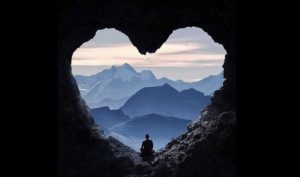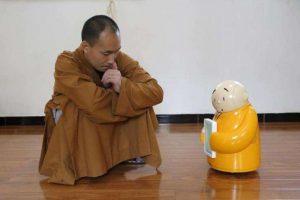
I have been writing this column for almost eight years now. When I look through the scope of topics that I gravitate toward, I notice that each month I have the same feeling: “What could I possibly write about now?” Like an artist with blank canvas syndrome, I wonder what new thought I could bring to the page. The themes I seem to return to again and again are those involving how to live, the centrality of meditation, death and dying, the arts, self-expression, the rights and welfare of animals, ecology and activism, and what it means to be human here and now in these seemingly impossible times.
It is true that in every recorded human timeframe, people always seem to think and write that theirs is the time: of the most intense situations or problems, conflicts, concerns, advances, and so on. But aside from the threat of nuclear action, war, and potential devastation during the Cold War—and various other periods throughout history—have there actually been any other points in the human timeline when human-created disaster, violence, and destruction were ever as dire or as potentially holistically threatening to life on Earth? I’m not a historian, so facts, dates, and extreme accuracy or positioning don’t interest me. I’m an artist at heart, a free-thinker, and a creator, although it has been a long time since I’ve created anything more tangible than baked goods, window curtains, or handmade gifts for nieces and nephews.

This leads me to feel that I’m not offering anything substantial, crucial, or inextricably needed to our human community. But I know this is not true, for each one of us has a value in our basic existence. Our human goodness has the potential to offer more than our daily complaints or begrudging work. Each of us is here to make a difference, however minute or however unrecorded. Crucial contributions are regularly made and not captured by social media, smartphone camera, voice memo, or selfie. Actual human interaction is still the currency of intimacy, belonging, and a life well-lived.
The mere fact that I am still able to wake, to bend my creaky limbs, to put on shoes and walk in the woods nearby, simply regarding the still pond, feeling the breeze in the leafless branches, woodpeckers flitting from trunk to trunk in search of grubs in the brittle bark. There is no further purpose perhaps than simply being, although the urge is strong to find one—a reason why we linger here while aging, combating depression, and a feeling of idle impotence in the face of world broadcasted brutalities. I read the stories of those who live impressive lives, tragic lives, interesting or comical lives, and if there is any common thread among them it is one that I also share.

We are only truly human in relation to one another and to the animals, the insects, and to the soil and sky, clouds and flowing waters. Behind this building, though a muddy stream at best, I know the river to which it flows. I know the larger river it will join and I know the sea—although hours from here—that all these waterways grieve toward and cleave to.
Winter is the hardest time. My limbs reject it, craving the warmth of sun, air, and earth. Yet winter is the time to seek our own inner mettle, to know the limits of our striving, our hope, and our reaching out rather than inward for sustenance. Each fall I think, “I cannot do this one more time. I am a spring and summer creature!” This freezing coldness, boundless darkness, short days meting out scarce hours of tepid sun in the pale gray sky of longing toward buds of spring.
Death is an easy companion for winter thoughts, winter writing, winter artwork—death is all around us and shows our buoyant craving for life, connection, and belonging. In winter we seek belonging within our very bones and sinews. It is a natural time for meditation, for contemplating our own demise, and for embracing our inner artist, whatever that may mean. We simply fold the laundry well and take our time to face the chores of the day, the hours of the work week with discipline and devotion to what is essential. We can imbue our waking hours with the wooly wish for the awakening of all beings, especially in these dark times, by protecting the inner flame that burns in each of us. We revere life, no matter where it originates. However feeble or mighty our conviction, we yearn for some kind of future to believe in, belong to, and create in.

As Buddhists, we know our days are numbered, like these shortest days in the Northern Hemisphere leading toward the winter solstice on 21 December, so we cultivate the inner light of lucid knowing. We pray ourselves and others may sense too—even the beetle on the window frame, the squirrel in the garden, the neighbor’s cat hovering about the porch, as she braces her back against a cold wind, yet faced fully toward morning and its sun-filled possibilities. Solstice comes from the Latin meaning, sun stands still. Let us take a moment to pause, embrace the stillness, and in that space make a prayer for all sentient beings:
May all beings be free.
May all beings be happy.
May all beings know the source of happiness and freedom.
May all beings never be parted from the source of freedom and happiness, now and ultimately.

Related features from BDG
The Marriage of Form and Emptiness
Death and Decay, Birth and Rebirth: Cycles of Life in Nature and Ourselves
Drafty Windows
From Vesak to Solstice: Connecting Through Festival
Buddhistdoor View: The Winter of Uncertainty – COVID-19 and the World
An Ode to the Canadian Winter














